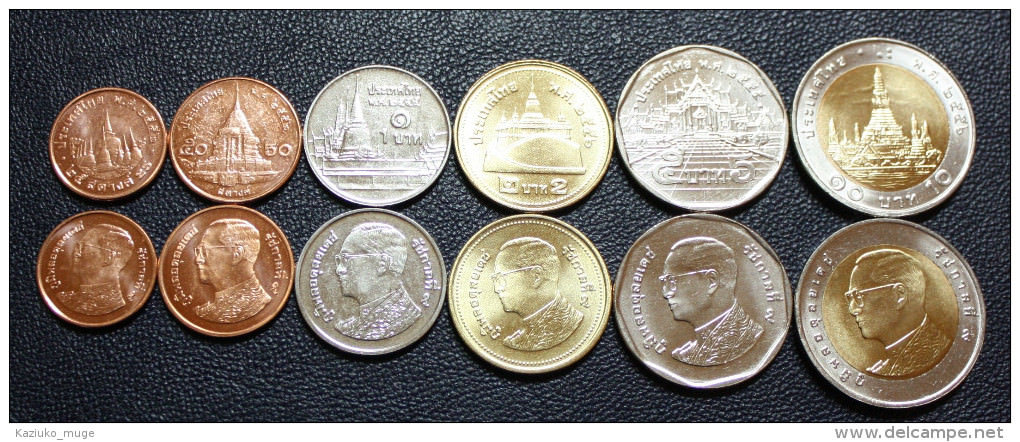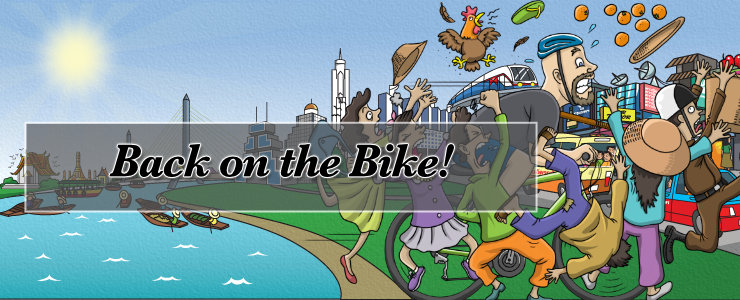As a Canadian, I grew up getting used to throwing away money. Okay, not real money – pennies. In Canada GST is added to everything, so if a price tag says $2, the actual price will be like $2.28 (in Thailand, if the price tag says 143 baht, it’s 143 baht). But the pennies that accumulate in the transaction were the bane of many Canadians’ existence, piling up, filling pockets and jars, and generally being nearly useless (until they discontinued them in 2013). But that was nothing compared to the Thai equivalent – the dreaded satang coin.
The satang – which comes in denominations of 0.50 baht and 0.25 baht – is even more useless. They’re tiny, nearly weightless, and easy to lose. If you had a pocket bulging with them you might be able to buy yourself a cheap bowl of noodles, but not much else. Very few people pay for things using satang, so it’s almost always the customer that is getting satang, rather than giving it away.

Look at the stupid little things, just sitting there all smug on the left.
So what to do with them? I used to keep them – putting them in a little bag for my infant son to play with one day in the future – until I realized he could eat them or spill them all over the floor (which would necessitate picking them up individually by hand). I hate carrying the stupid little things in my pocket, so I started doing the only sensible thing – throwing them away.
This is the very definition of first world problem, of course, and I realize that this might seem to some like an arrogant, wasteful thing to do, but they always seemed to accumulate, and never get spent. So on a whim the other day I posed the question on Twitter – what do you do with your satang? I thought it would be interesting to display some of the replies here.
Serious question: what do you do with satang coins? I usually just end up literally throwing mine away.
— Greg (@BkkGreg) September 12, 2016
@BkkGreg I throw them away as long as my wife doesn’t see me or else she goes nuts!
— Phil / Ajarn.com (@Ajarncom) September 12, 2016
@Ajarncom @BkkGreg donate them. And or use them. It’s money ; )
— Lini’s Choice (@LinisChoice) September 12, 2016
@BkkGreg I use them to buy milk, which coincidentally is also how I get them.
— Viljar (@viljariverden) September 12, 2016
Go to foodland, they price items in satang denominations. https://t.co/8Xq3L1hx4y
— RebelW/aCause (@KobkarnL) September 12, 2016
@BkkGreg donate to charity. like animal shelter, many boxes at BTS stations
— thomas wanhoff (@thomaswanhoff) September 12, 2016
Donate them 🙂 https://t.co/Ge4ERv96ij
— Sumalee Sappan (@sappan_sumalee) September 12, 2016
@BkkGreg throw them in a jar. Maid counts them and changes them for 100’s and takes a cut.
— Aretu Deetoo (@aretudeetoo) September 12, 2016
@BkkGreg I put them in a cup and from time to time use them at the 7-11. Now about those damned stickers . . .
— Coco Nutts (@View_BKK) September 12, 2016
Accepted at 7-11 and supermarkets. No reason to throw them away. Also can be used on public buses. https://t.co/D7jhFaKuQD
— Random Expat (@randomexpat) September 12, 2016
@BkkGreg Put em aside then give them to the poor sitting at the entrance to the BTS.
— Khun Steven (@KhunSteven) September 12, 2016
@BkkGreg @StickboyBangkok pay to a cheeky taxidriver
— mango juice (@mangojuice77) September 12, 2016
@BkkGreg buy a piggy bank for you kid and when it’s full go to the Government Savings Bank
— Mister-Kwai.com (@misterkwai) September 12, 2016
@LinisChoice @Ajarncom @BkkGreg leave them behind.
— I Prahin (@iPrahin) September 12, 2016
@BkkGreg Use ’em to pay for merchandise at 7-11. They’re always glad to take them.
— Dan_in_BKK (@Dan_in_BKK) September 12, 2016
@BkkGreg I have accumulated a massive bag of them – can I give them to you?
— Neil Shelley (@NeilShelley) September 12, 2016
@BkkGreg not sure where mine go! Probably into 5 y.o. son’s omsin. Let SCB deal with them. Good point though, what’s the point?
— John Roberts (@elehelp) September 12, 2016
I usually look for donation boxes and occasionally spend it if I have they worth bahts total. https://t.co/yuHNVpU2tB
— ThaiCultureGuide (@TCG_Sam) September 12, 2016
@Dan_in_BKK @BkkGreg Once cornered by homeless guy, gave him all coins in my pocket. He patently sorted thru them & left behind anything <5฿
— ρhαετhøṉ (@PhaethonTweets) September 12, 2016





I used to get them when I bought bus tickets that cost 6.50 Baht and paid with 10 Baht (when I didn’t know if the ticket will be 6.50, 8 or 9 Baht). Now I carefully look if ticket price is displayed somewhere in the bus, and if not ask fare collector, and that’s where I get and use most of them (25 and 50 Satang coins). Sometimes I use them in 7-Eleven. Side note: places that don’t have goods that are priced in .25 or .50 usually don’t even accept Satang.
Ah, that’s interesting. When places start refusing legal tender currency, you know it’s kind of a useless things to have. 🙂
@BkkGreg Usually find them stuck to my iPad when retrieved from an all-purpose tote bag as the iPad’s cover uses gazillions of magnets to hold it in place and the satang coins are steel. 7-11 and Lotus are the only stores around my that insist on giving satang as change.
Never thought of that – passing a strong magnet over my change jar to get them out. Gives me an idea though – might be fun to get a magnet and do experiments with my kid when he’s old enough to know not to eat them. 🙂
Getting one of those 7-Eleven cards kind of solved the problem by drastically reducing the number of any coins (and especially Satangs) I receive. Paying everything else with a credit card that gives Thai Airways points always helps (including refilling my rabbit card). The remaining few coin survivors band together to provide ammunition for next time I need to kill 15 minutes by arguing the concept of legal tender.
That’s a good point – I see those Rabbit cards in more and more places lately, might be a good idea to use it from time to time.
I used to put them in a plastic bottle and leave on top of the rubbis hfor the plastic recyclers, I’m guessing that they be one group that might enjoy getting them. Seeing as the police in pattaya raided a squatters slum one time on gambling charges and caught them gambling with Satang coins they do have some use.
That’s a good idea, I might do that. Certainly easier than filling a random plastic bag with them.